I have often thought about how much chance, or fate, dictates the direction of one’s life. Some—including me—might also attribute surprising occurrences in their lives to “divine intervention,” but this isn’t the place for a theological discussion.
Let’s simply agree that regardless of the possibility of any spiritual involvement, being in the right place at the right time can shape your life, as surely as being in the wrong place can cost you your life.
Fate, or something higher, caused me to be in the band room on a certain day at Heinz Kaiser Junior High School (as it was known back then) in Costa Mesa, California. It was during the summer of 1969. I had just graduated from that school, and was spending the summer helping the school’s band director, Ken Owen, with his summer band program. I’d been playing the trombone for about three years, so this certainly qualified me as an authority with the beginners in the summer band. Drawing on my wealth of experience, I coached the trombone and trumpet players as they read through the same beginning band books I’d used with Mr. Owen just a few years earlier.
On this particular afternoon, the class had just ended. It was a warm, sunny day, and the doors were wide open. In walked a handsome, preppy-looking guy. He was tall and slender, wearing a white turtleneck and white pants and shoes. He had sun-bleached blonde hair, and looked like he’d stepped off the set of an Annette Funicello movie.
“Hi, Mister Owen!” he said.
Mr. Owen turned around, and smiled.
“Doug!”, he said. “Welcome! How are you doing? What’s going on? Still playing piano?”
Doug said, “I’m fine, thanks. Yes, I’m still playing. I learned three more rags last week. I hope to get a gig at Disneyland someday.”
Mr. Owen turned my way and said, “Danny, this is Doug ______. Doug is a senior now at Harbor High School. He plays ‘ragtime’ piano, and is interested in early jazz.”
“Yeah,” said Doug. “In fact, this Saturday, I’m planning on going over to the Pizza Palace in Huntington Beach. The South Frisco Jazz Band plays there every Friday and Saturday night.”
“South Frisco Jazz Band?” I said. “You mean, like a Dixieland band?”
Doug looked at me with a high-school-senior smirk. He said, “We don’t use that word for it. To us, ‘dixieland’ means straw hats and corny, commercial stuff. We prefer to call it ‘traditional’ jazz. The South Frisco band plays real, authentic jazz, like it was played in the 1920s.”
“Wow!”
I wanted to let Doug know I knew something about this, so I ventured, “My older brothers let me listen to one of their LPs. It’s called Pete Kelly’s Blues, by a band called ‘Pete Kelly’s Big Seven.’ So I know a little about, uh, traditional jazz…”
Again the smirk. “Well.” Doug said, “I know their records. That’s a really good Hollywood studio band. But the South Frisco guys are…more authentic.”
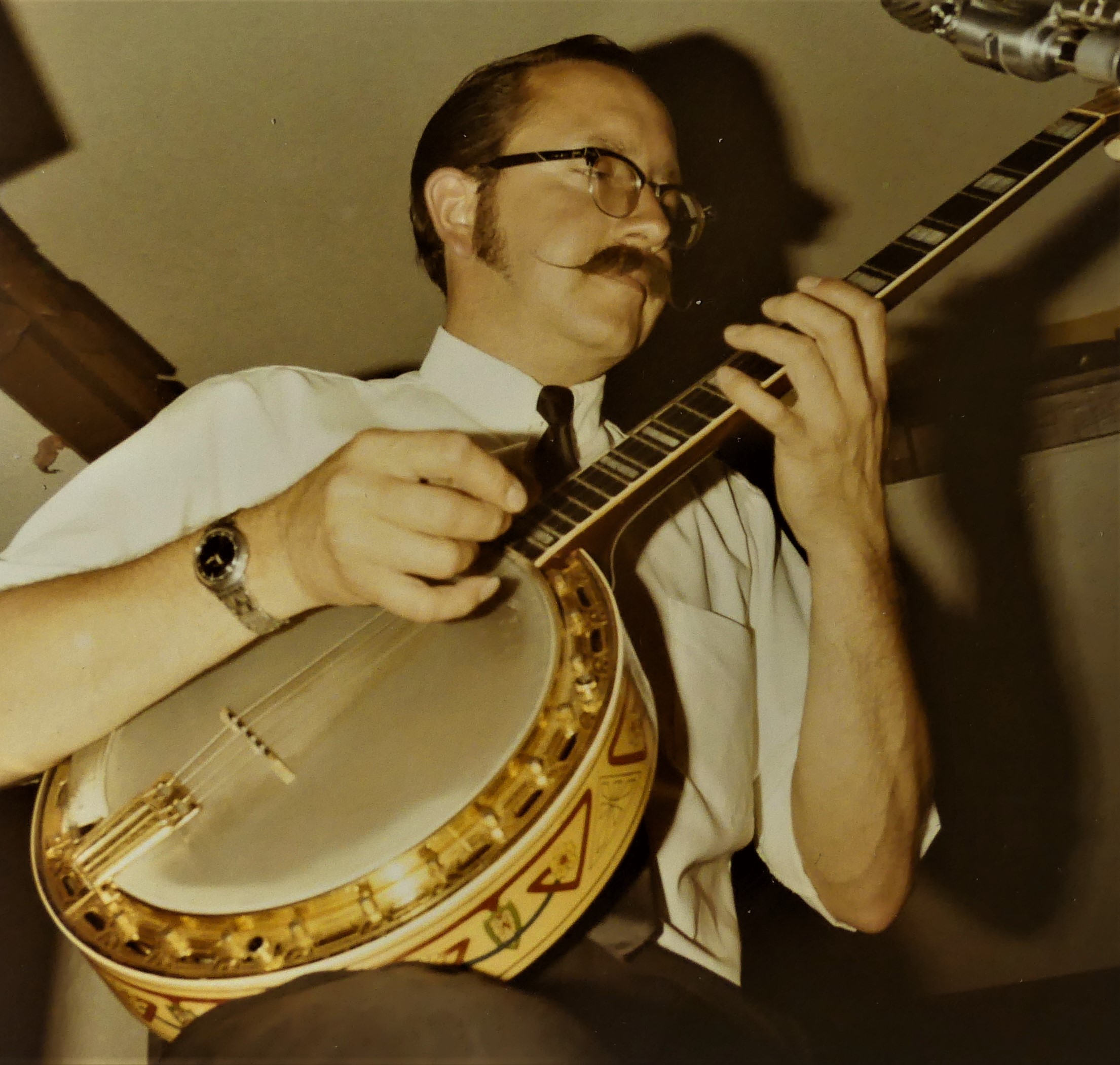
Doug continued. “They have seven pieces: a cornet; clarinet; trombone; tuba; banjo; piano; and a guy who plays unbelievably hot washboard. The clarinet player also plays alto sax sometimes. The banjo player is the leader. His name is Vince Saunders. He has a big black handlebar mustache. He sings some tunes, too.”
“Wow!” I said again.
Mr, Owen was hanging back, enjoying this exchange between the novice and the seasoned high school senior.
“You know, Danny,” Doug went on, “I’ll give you my phone number. If you want, have your parents call me. If they say it’s OK, I’ll pick you up on Saturday and take you to hear the band. They play at a neat joint called the Pizza Palace.”
What could I say? “Wow!”
So, on Saturday night, I found myself at the corner of Brookhurst and Adams in Huntington Beach. Doug parked his Porsche, and I got out. It was a warm, southern California night. I remember the excitement I felt that night, and every night I went there, as I walked across the parking lot, and approached the big wooden doors of the Pizza Palace. I heard some boisterous music coming from inside. It was exciting! Doug opened a door, and the music was suddenly a lot louder, and even more exciting. We walked in.
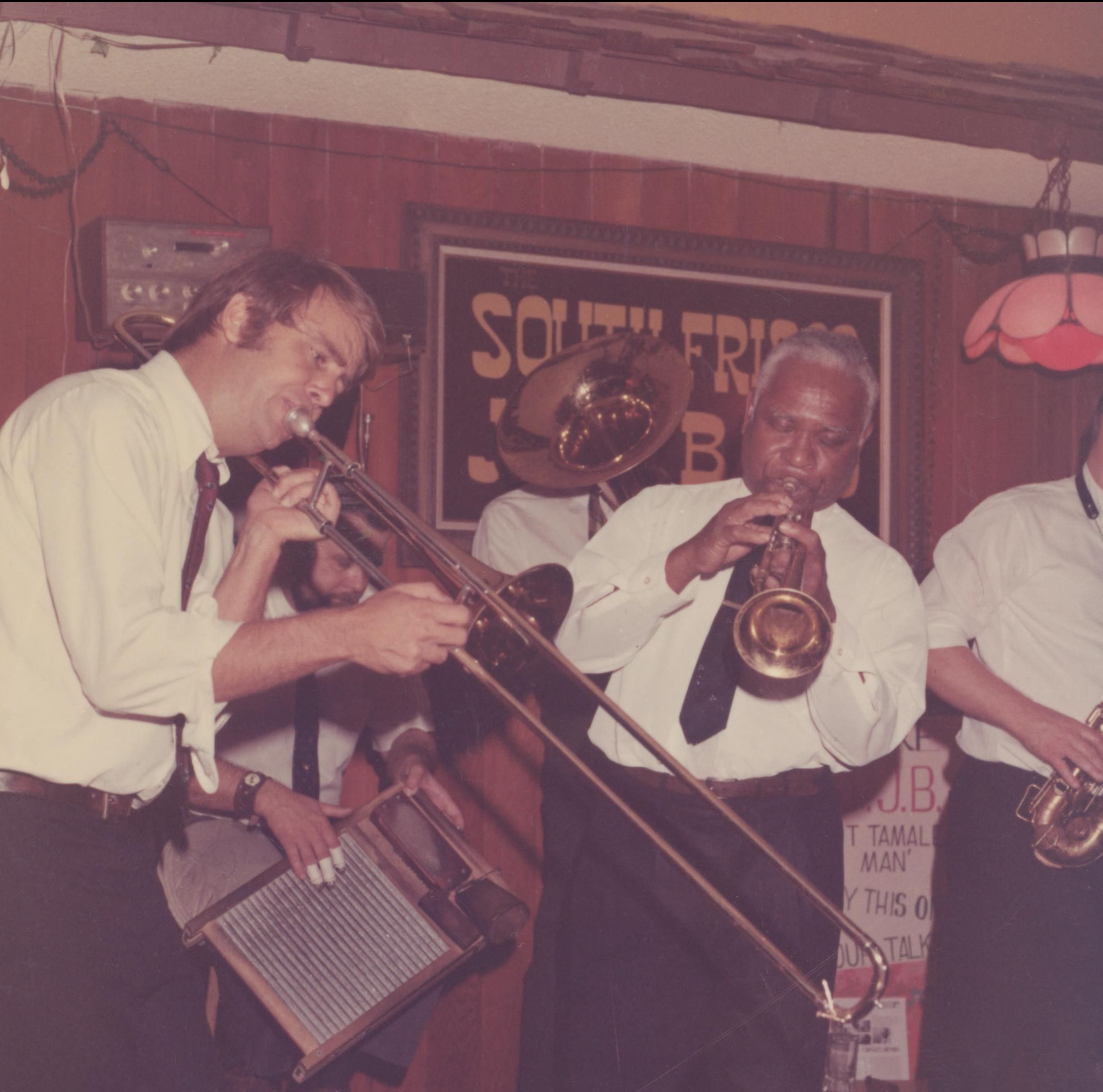
The place was crowded. Several families were sitting at dark, varnished patio benches with little candles in round glass holders. Others were at other benches, sipping beer from frosted mugs with pitchers nearby for quick refills. The place was full of cigarette smoke. (1969, don’t forget!)
At the far end of the rectangular room was the bandstand. It was low, just big enough to accommodate the seven-piece band and the upright piano. I noticed the piano was painted a light lemon yellow. It was placed at “stage left,” set up so the pianist’s back was to us. (An earlier photo shows the band with Vince and the piano at “stage right.” I don’t know what prompted the change). The band’s regular pianist was the great Robbie Rhodes, still active at this writing. That night, however, the late Ron Ortmann was playing. Vince Saunders, the bandleading banjo player, was perched on a bar stool next to the piano, at the edge of the stage, strumming his beautiful Vega Vox plectrum banjo.
The front line—trombone, cornet, and clarinet–stood at the front of the stage, with a bench from one of the patio tables set up lengthwise in front of the three players. This was where the guys set their mugs of beer. Roy Brewer, an accomplished local trombonist, was subbing for Frank Demond. (Roy is on the band’s first recording. It was an LP on the Vault label called, Here Comes the Hot Tamale Man, with delightful, Peter Max-influenced “psychedelic” cover art). Al Crowne was playing cornet. Mike Baird played clarinet. He was amazing, and still ranks as one of my favorite blues players.
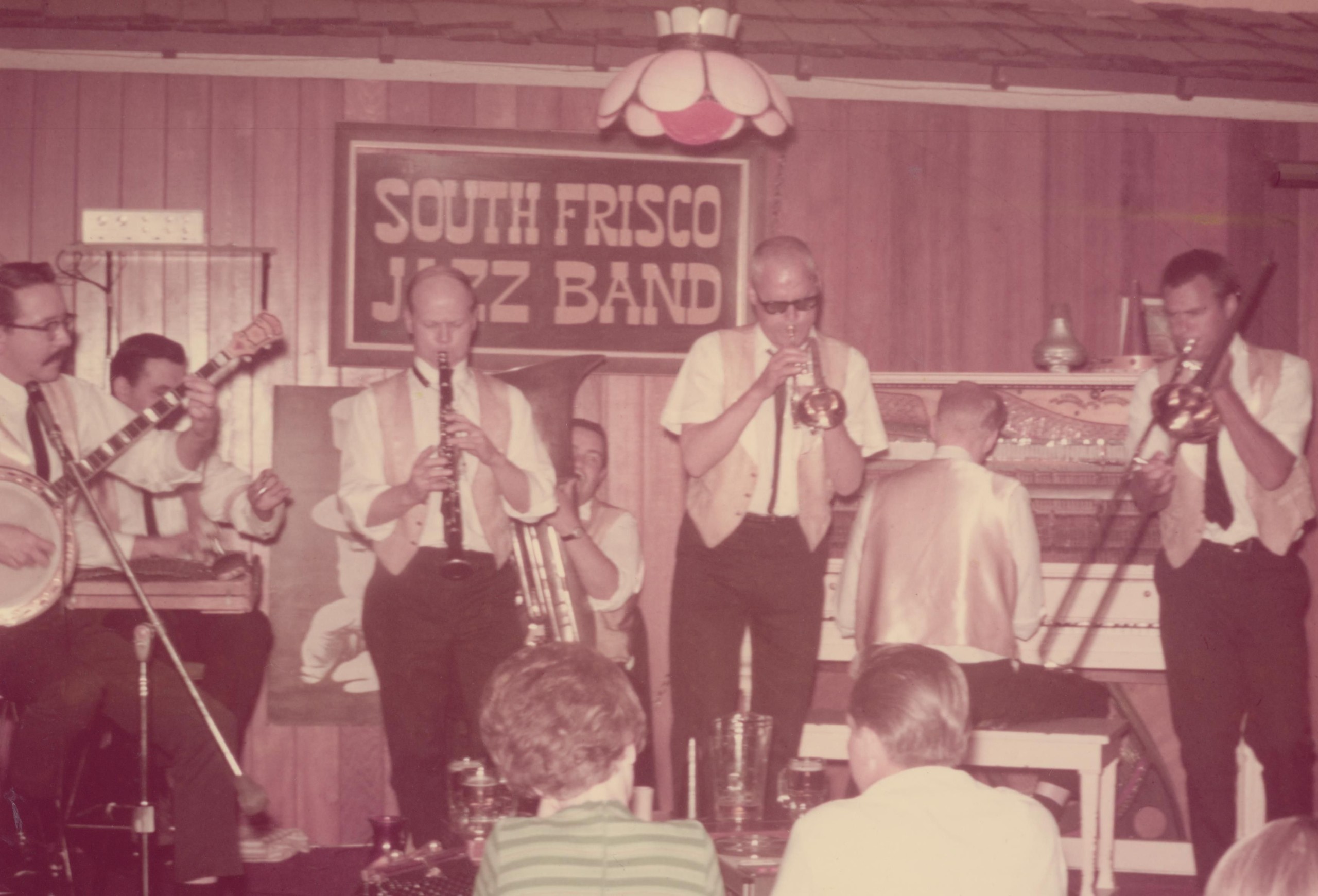
Behind the front line you could see Bob Rann’s silver upright tuba and on the end beside Bob Rann was Bob Raggio, smacking out the rhythm on a vintage washboard. His fingertips were capped with thimbles, held on by white masking tape.
Doug and I found a table. I used money my parents gave me to buy us a pizza and a pitcher of root beer. (Ah, youth!) The music captivated me instantly. It was in-your-face: loud, and honest and true. Al Crowne played the melodies with a dancing kind of “lift,” and the way Brewer and Baird wove their lines around him made me think of a musical kaleidoscope. It was wonderful.
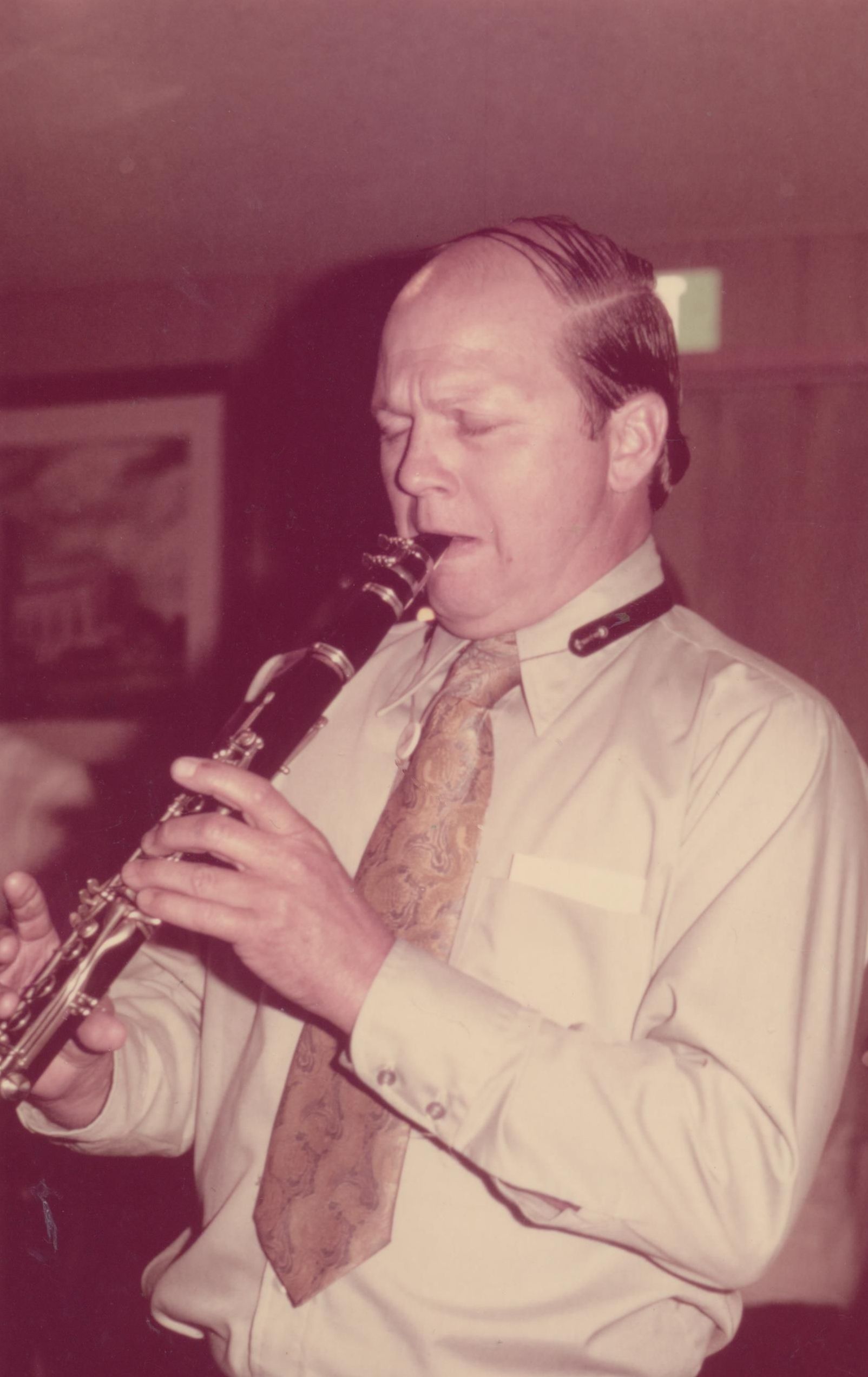
Needless to say, the Pizza Palace became my weekend home away from home for the next few years. I met many musicians there, and made more friends than I can count.
Jazz attracts an interesting mix of people, doesn’t it? There was Hal Newman, who would often bring in a top-notch reel-to-reel recorder, and, with the band’s permission, record the band. (No, I don’t know what happened to those tapes). At the end of each break between the sets, Hal would urge the band back to the stage by shouting out, “Jazz time, kiddies!”
I have cassettes I made of the band where, in the middle of a hot tune, you’ll hear a voice over a loudspeaker in the background shout out, “Pizza order number sixty-three! Sixty-three!”
After each set, the tuba player, Bob Rann, would reach up behind him, and draw down a good-sized movie screen. Vince would hurry to a closet behind the bar, and wheel out an old Bell and Howell film projector. He’d set it up in the middle of the room (with the diners wondering, “What the hell?”), plug it in, and start it up. We’d spend the breaks watching silent movies; usually Laurel and Hardy, but occasionally Buster Keaton and others. It was years later that I found out Vince was upholding a tradition of sorts. I learned that Lu Watters used to show similar silent films at his club in El Cerrito: “Hambone Kelly’s.” “South ‘Frisco” indeed!
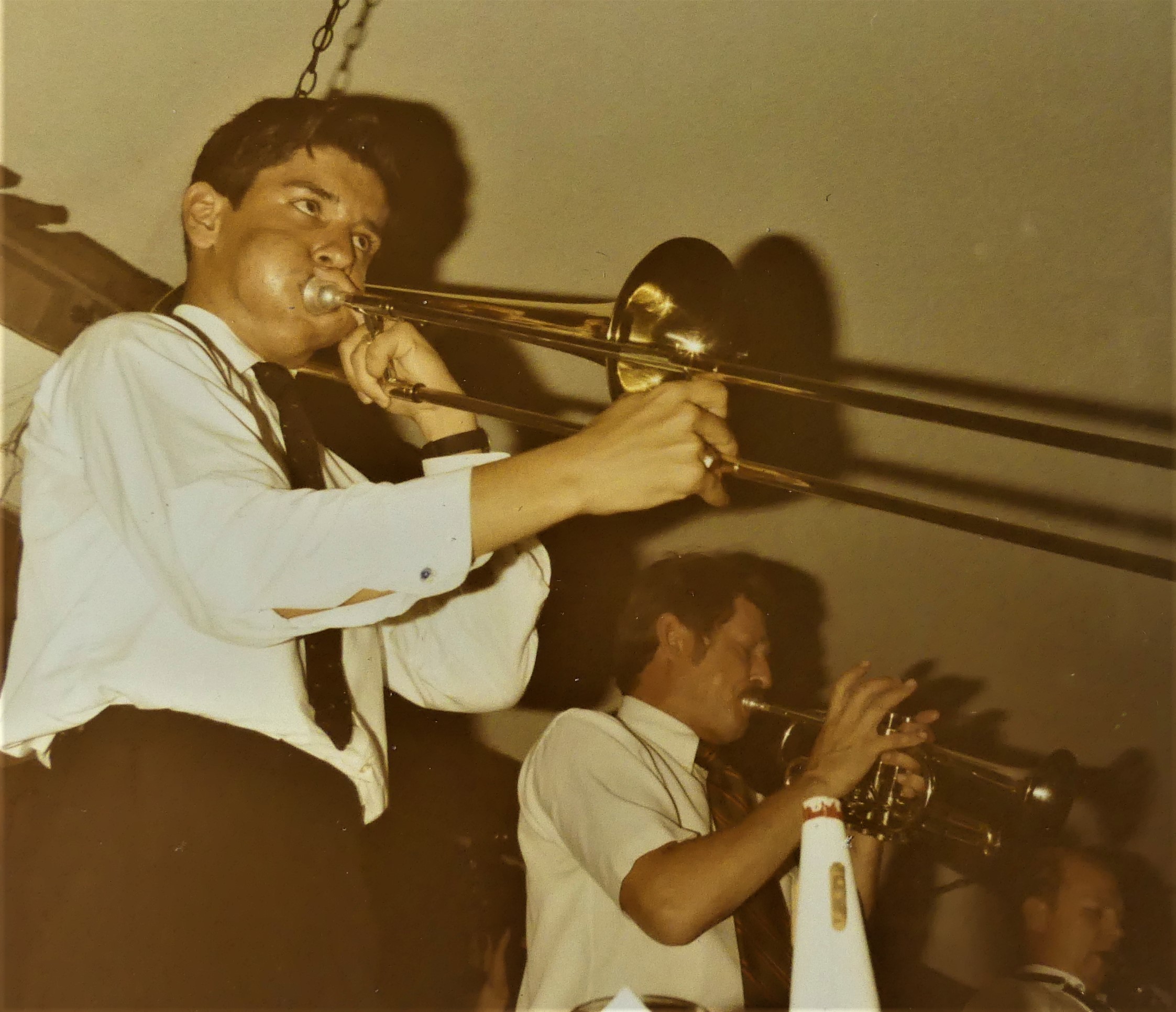
One night, the band finished an especially inspired rendition of “King Chanticleer.” We all heard the loudest—and lowest—voice in the world holler sarcastically from the back of the room, “Why don’t you guys play something HOT?!?” This was our introduction to Gerald “Murph” Murphy, a charismatic, extroverted guy who worked on offshore oil rigs for a living. He’d learned about trad jazz from his father and had somehow discovered the Pizza Palace. He came to hear the band whenever he was in town. Gerald’s bass-baritone voice was as deep as Paul Robeson’s, only ten times louder! He became one of my closest friends. A truly good, and funny, guy.
One night, the staff was having trouble keeping up with the orders. Someone didn’t show up, or something. The owner, Al Lee, saw Murph hooting and hollering at our table. Al came over and said, “Hey, Murph! You’re here every Friday and Saturday night anyway. Why don’t you work here? I could use the help.”
Gerald looked at him, then looked over at me and grinned. “You mean you’d pay me to listen to my favorite band? Sounds like a deal!”
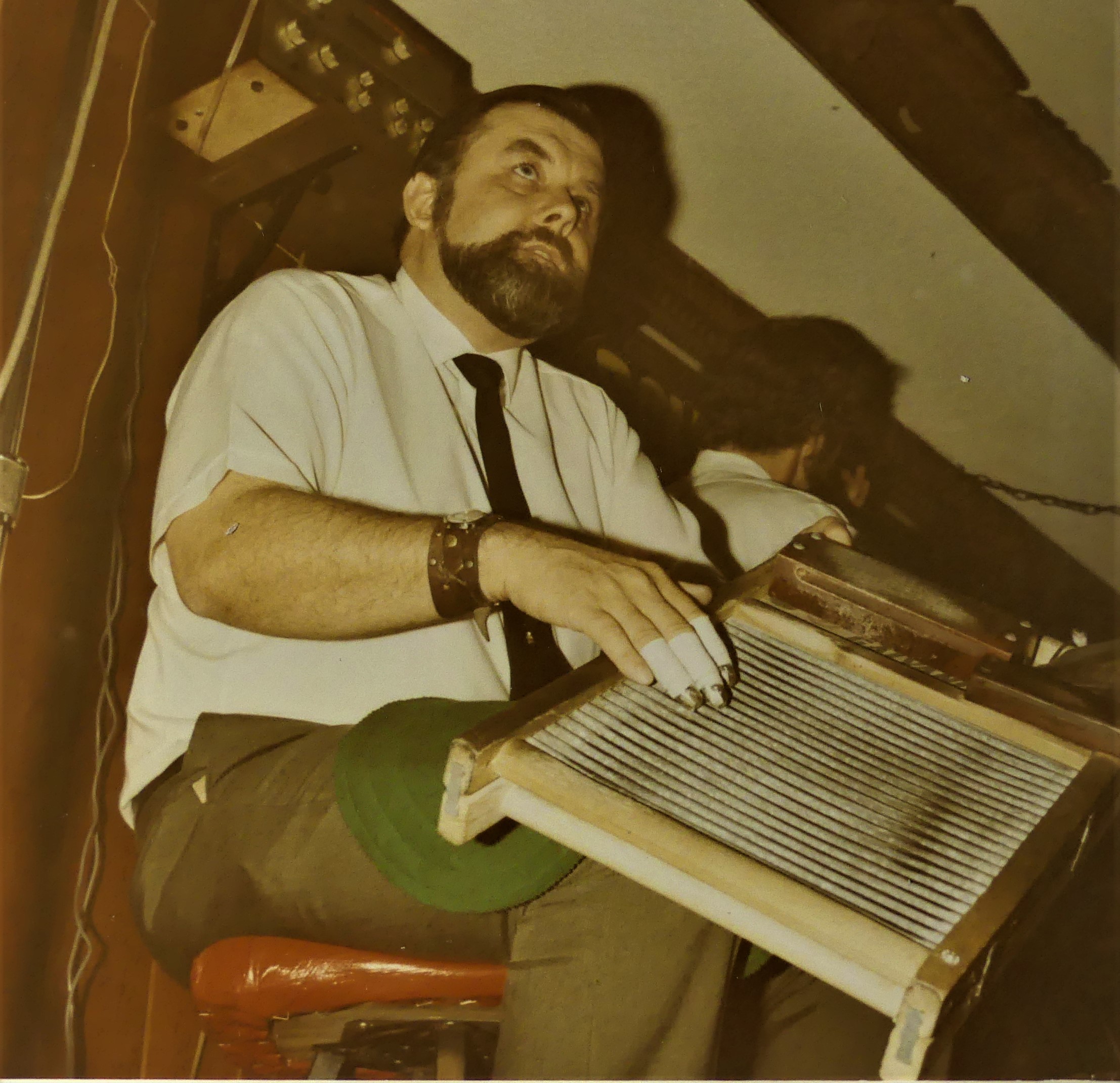
Al took Murph into the back. A few minutes later, Murph emerged wearing a red-and-white striped shirt, about two sizes too small for him (Murph was a big guy), and a silly-looking Styrofoam straw hat sitting on the crown of his head. Al put him behind the bar. Murph started dispensing pitchers of beer, and mugs of soft drinks. An occasional glass of boxed wine. Nothing but the best at the Pizza Palace!
The following Friday, Murph was behind the bar, and I saw Al go over to him. They spoke for a little while. Then Al was laughing, and Murph started laughing. They shook hands, and Al slipped him a few bucks. Murph took off his striped shirt (he had a T-shirt underneath) and spun his faux straw hat into the audience. With some agility, he jumped up onto the bar, and spun himself around, jumping off onto the audience side. He came over to my table and sat down, hooting and hollering at the band again. He’d just been fired! Al told him he’d been watching him for the past few nights, and that Murph wasn’t ringing up the beer he was supposed to be selling. Murph explained, in his completely guileless way, “Hey Al, these people are my friends! I can’t ask them for money!” That’s when Al started laughing, as he fired Murph with no hard feelings.
Some nights, we’d arrive to find the legendary cornetist Ray Ronnei playing lead with the band. He was special, too. I found out years later that Ray had roomed with Papa Mutt Carey, who had played cornet with Kid Ory’s band going back to the 1920s. Ronnei’s playing reflected the strong impact Carey’s playing had made. I think the early New Orleans cornetist Freddie Keppard was another of Ray’s influences. Ray’s playing was from another time, and incredible to hear in person. Ray also sang in a very personal, affecting way. I still remember how he’d sing “How Long Blues.” It was all his own.
Then, there’s cornetist Al Crowne. Al was a stockbroker by day. He’d heard that cornetist Rex Stewart (a star of the classic Duke Ellington Orchestra of the 1930s and ’40s) had moved to Los Angeles. Al called Rex, and began studying with him. One day, Rex told Al he wasn’t going to charge him any more for lessons; they had become friends. It was Rex’s Conn Connstellation cornet that we heard Al play at the Pizza Palace. Shortly after Rex’s passing, Rex’s widow called Al. She told him Rex wanted Al to have his horn.
Pianist Robbie Rhodes—still hale and hearty at this writing, and still playing amazing piano—reminded me of one memorable anecdote about Al Crowne.
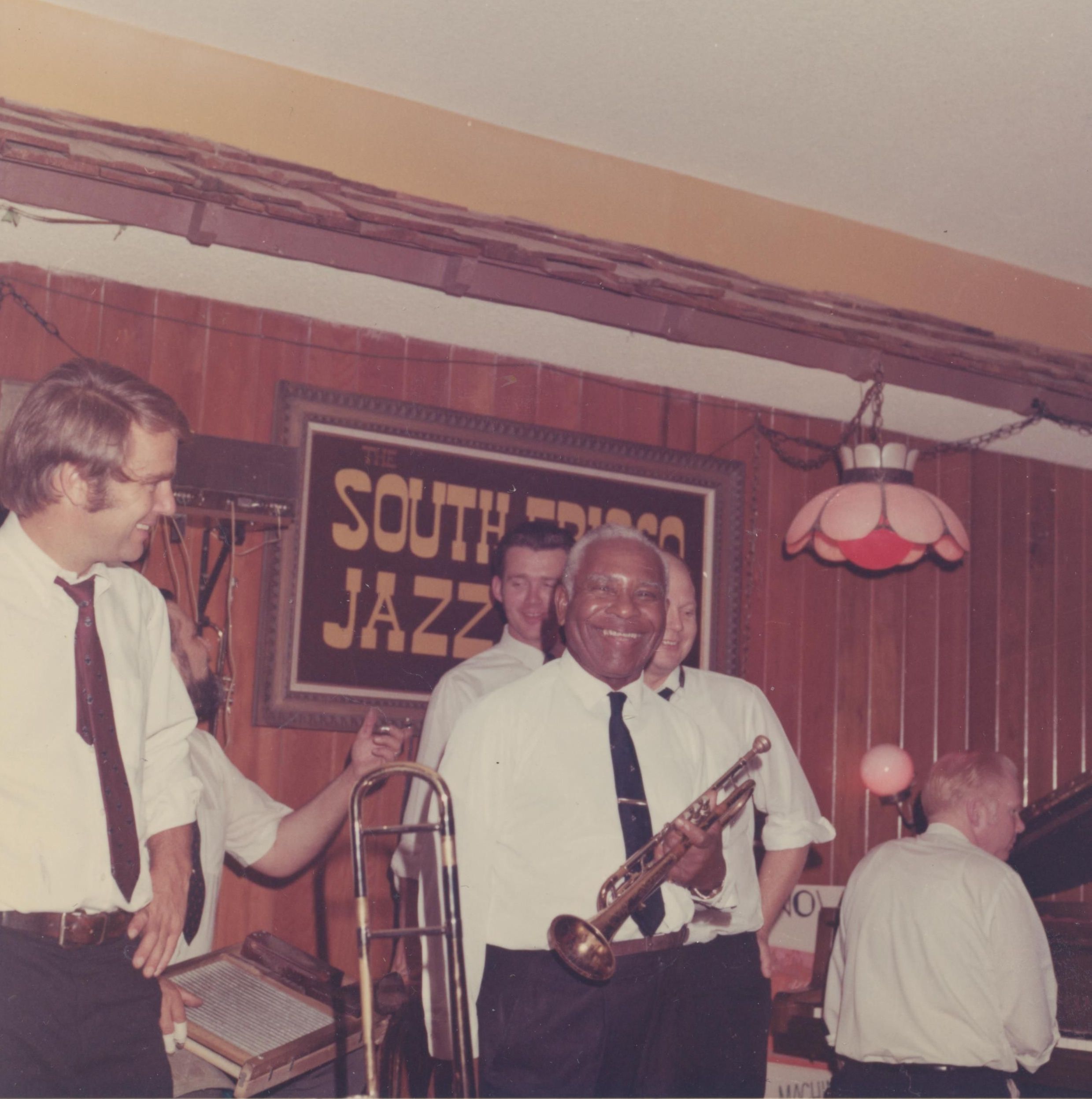
The SFJB was always given to laughing, and good-natured onstage bantering. One night, we in the audience noticed the guys were having an especially hard time holding it together; before, during, and after each tune. Finally, one of the fans hollered out, “C’mon, Vince! Let us in on it!”
Vince caught his breath, and smiled as he reached for the old silver Shure microphone. Frank Demond clapped his hands, and said, “Yeah, Vince, tell ‘em all about it!” This provoked more laughter from Mike Baird, Bob Rann, Raggio, and Robbie Rhodes. I noticed Al was unusually quiet. Could he actually be blushing?
Vince said, “I’m sorry ladies and gentlemen. We don’t mean to be rude. You see, our cornet man, Al Crowne, he…well, how can I put it? Al saw a movie recently that changed his life.”
Vince looked over at Al. Vince said, “Would that be the way to put it, Al?”
Al was looking at the floor as he nodded. The band chuckled some more.
Vince looked out at the audience. “The new movie Al saw is called Papillion. That means “butterfly” in French. More laughter from the guys, Vince included.
He went on. “It stars Dustin Hoffman and Steve McQueen. I haven’t seen it, but I guess it’s terrific.”
Al blurted out, “Oh, it is!” This prompted laughter from everyone.
Vince, still laughing, said, “Al, you really should let our friends in on this. Come on, show us all just how much that movie meant to you…”
Al looked around the bandstand, and then out at the audience. He seemed resigned to his fate. Al took his black tie off, and began to unbutton his white dress shirt. He removed the shirt, and handed it to Demond. Al looked around the room again, and suddenly lifted his white T-shirt all the way up to his shoulders.
In the exact middle of his chest was a gigantic technicolor butterfly! The tattoo work was exceptional. The audience roared. The band was fit to be tied.
Al eventually got himself dressed, and Vince said, “After all that, Al, why don’t you pick the next tune?”
Al said, “Sure, Vince. Let’s play ‘Poor Butterfly.’” And they did.
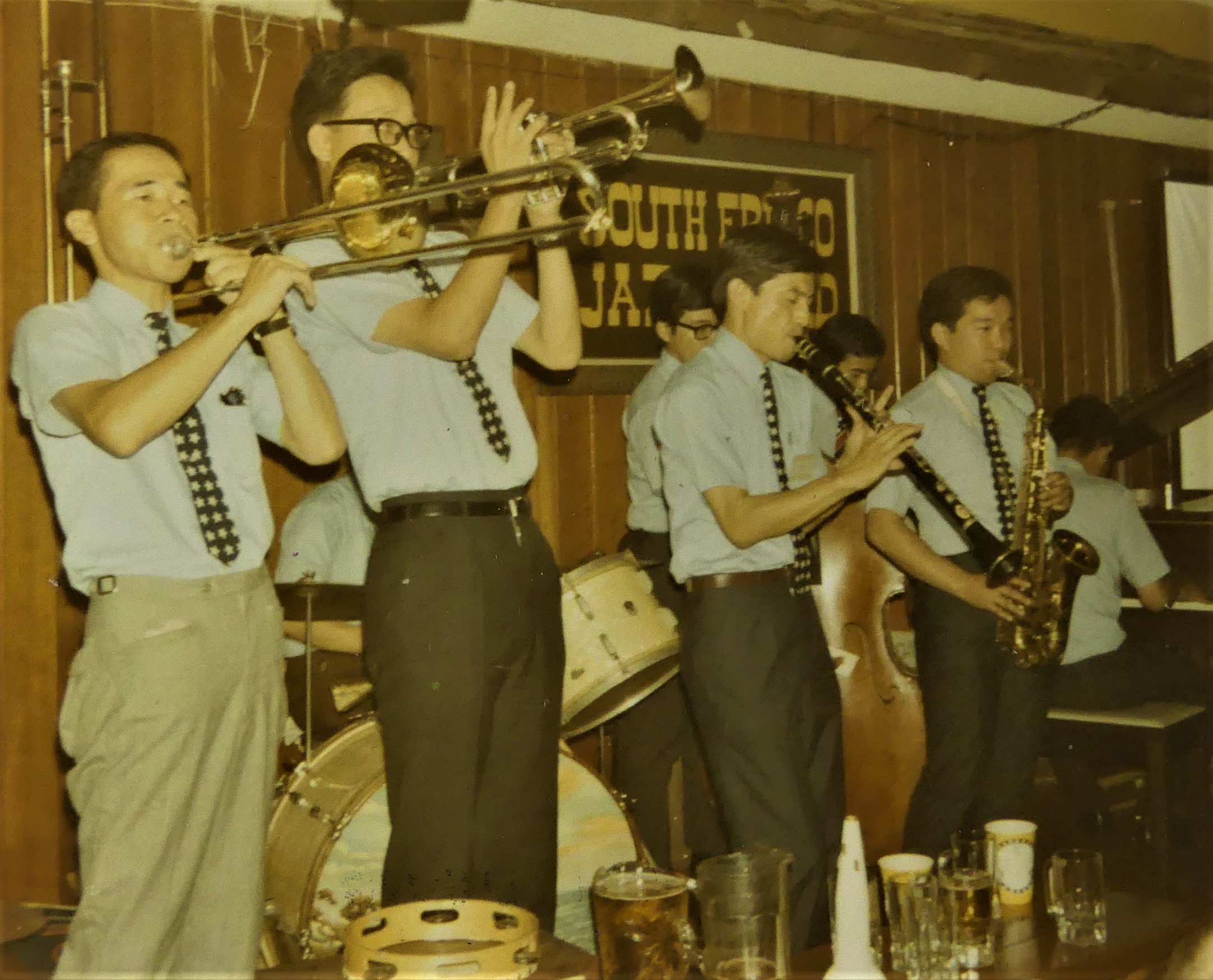
Occasionally, Vince would bring in the veteran trumpet player Andy Blakeney. Andy was born around 1898, so in the Pizza Palace days he would have been in his early seventies. He was still in great shape. Andy had played with King Oliver’s Dixie Syncopators in the 1920s, having replaced Bob Shoffner as second cornet. After that, he worked with Lionel Hampton for a while before finding a home as lead horn with Kid Ory’s band.
It’s still astonishing to think that when people heard Andy play King Oliver’s classic solo on “Dippermouth Blues” at the Pizza Palace, they were listening to a man who had heard King Oliver himself play it! That’s only one degree of separation! I also recall the excitement Andy could generate as he played the outchoruses of “Panama.” It was genuinely thrilling.
In the lineage of great trumpet and cornet players who performed with the South Frisco Jazz Band, mention must be made of yet another terrific horn man who found his way to the Pizza Palace. It was in the final year of the band’s long run. I remember walking into the Palace, and hearing a powerful but unfamiliar lead horn. A slim and trim cat with a thick dark gunslinger’s mustache was blowing the hell out of a Getzen Eterna cornet; the model Leon Oakley played with Turk Murphy’s band up north.
This new horn player was Dan Comins. It turns out he’d played with Bob Raggio at a club in Pittsburgh owned by the pro ball player Maury Wills. Of course, the club was called the “Stolen Base!” Dan’s father had been a good friend of pianist Ralph Sutton, and Dan had grown up with jazz in the house. He became a strong force on the southern California trad jazz scene and is still like another brother to me. Dan and Leon Oakley (with Bryan Shaw figuring in later) became a strong two-cornet team in Vince’s later edition of the South Frisco band.
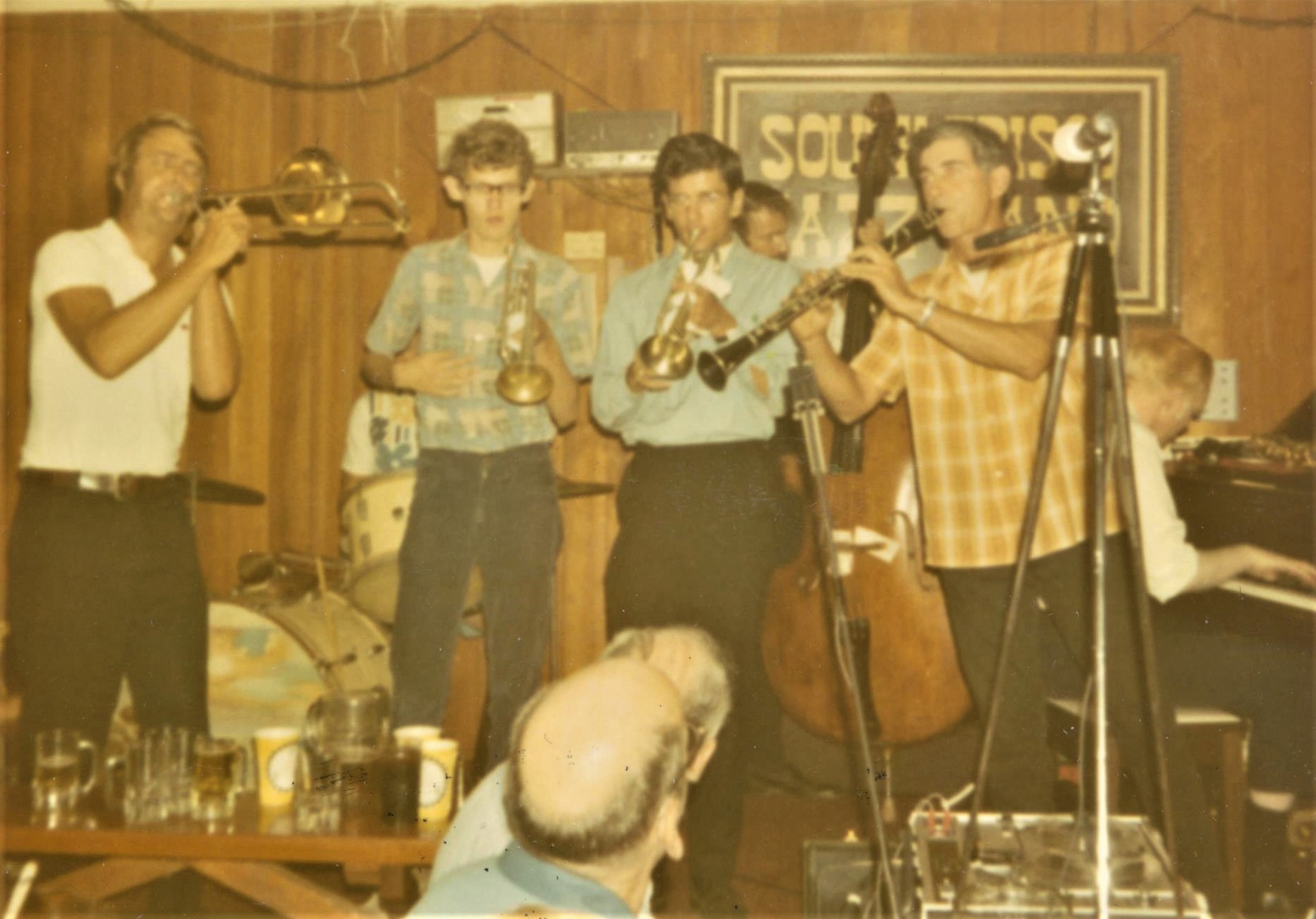
I mentioned clarinetist Mike Baird’s special way with the blues. After all these years, I still think one important reason the band was so special—and what separated the guys in the SFJB from the members of otherwise good trad bands up and down the West Coast—is, they all could play the blues. Whether playing an actual blues number, or a joyous up-tempo romp like “Big Bear Stomp,” the band played soulfully, man. You had to have experienced it to “feel” what I’m trying to put into words.
If more testimony as to the dedication of the band members is needed, consider this: trombonist Frank Demond gave up a successful contracting business in affluent Newport Beach, California to move to New Orleans and take the place of his hero, Big Jim Robinson, in the original Preservation Hall Jazz Band. Over the years, Frank has kindly and generously taught me about both music and life. Thanks, Frank. I haven’t forgotten.
As we continued to enjoy the South Frisco Jazz Band on weekend nights, one by one us younger denizens of the Pizza Palace were honored by invitations to sit in with the band. Bryan Shaw would join in, playing his father’s old Conn Victor cornet. Larry Wright (we called him Laurence then) would occasionally display his deep understanding of Bob Helm’s idiosyncratic clarinet style. We saw Hal Smith there often, of course, playing washboard. I flipped when I was called for the first time to “officially” play the gig with the band, subbing for the great Frank Demond!
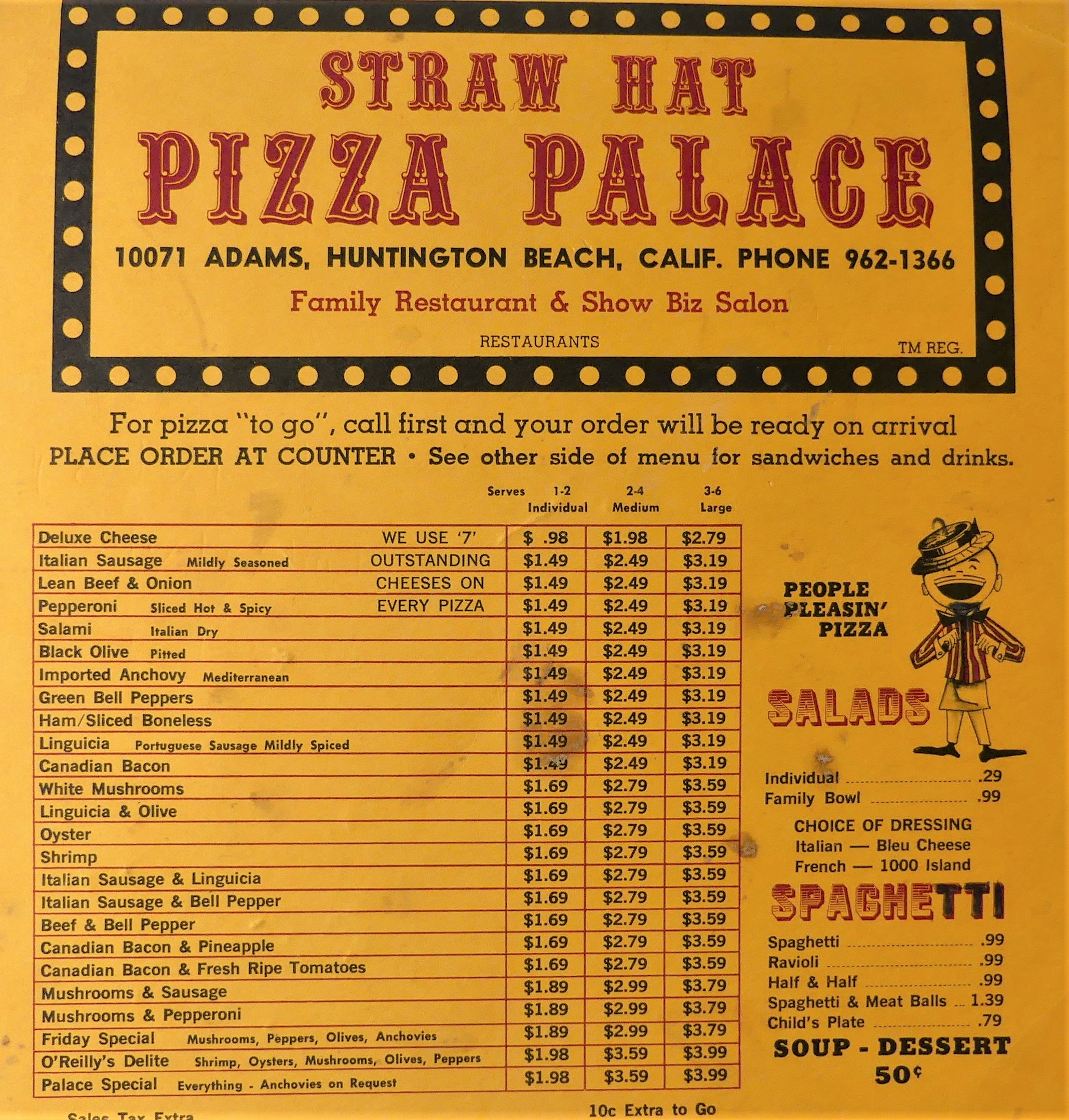
So, life went on. I graduated from Newport Harbor High School. Immediately after the diploma ceremony, my parents and I drove straight to the Pizza Palace. I remember everyone laughing as I sat in with the band, still wearing my cap and gown.
The Pizza Palace gig ended in about 1974. Coincidentally (or by fate?), I got called that year to lead a band on Friday and Saturday nights at a local Costa Mesa dive bar. The owner asked if I had a jazz band.
“Sure,” I lied.
“What’s the name of the band?”

“Uh…the Back Bay Jazz Band,” I said, using the name of the band I’d co-led with trumpeter Bryan Shaw back in high school.
“Oh, that’s a good name! Can you guys start this Friday night?”
“Uh…actually, we’re booked already for the next couple of weekends.” (I needed some time to get a band together!) I said, “How about three weeks from this Friday?”
“Well…OK. I’ll call again with the details.”
So, now I had a steady gig, but no band! So, who should I call? Well, I called Vince Saunders and Mike Baird from the South Frisco Jazz Band! Bryan Shaw played trumpet for a while. Later, Dan Comins took his place. Larry Wright was our pianist, and the immensely talented Paul Woltz kept us swinging on sousaphone.
After some time, Vince reassembled his band, using Dan Comins and Leon Oakley on twin cornets. (Bryan Shaw also played often with this edition of the SFJB.). Vince would bring in the late Jim Snyder, or sometimes Tom Bartlett, to play their Turk-inspired trombones. It was a powerful, brassy sound; different from the more “intimate” style of Vince’s earlier band. Other offshoots of Vince’s band were Hal Smith’s Down Home Jazz Band, and the recent Titanic Jazz Band. Both groups used members of the SFJB, with Vince’s blessing.
My experiences with the SFJB and those nights at the Pizza Palace gave me an orientation during those formative years of high school. I stayed focused on music and what I wanted to do with my life. Would that there were more bands around to do that for younger musicians today. I was very lucky.
Dan Barrett is a professional trombonist/ cornetist, arranger, and composer. He enjoys performing in admittedly old-fashioned jazz styles. He has recorded for Concord Records, Arbors Records, and his own Blue Swing Recordings label, among many other labels. Dan fell in love with jazz in high school, and learned to play from much older musicians from New Orleans, who had settled in the Los Angeles area. He has played at Carnegie Hall five times, and was featured in the last bands led by Swing Era icons Benny Goodman and Buck Clayton. Another highlight of Dan’s musical life—so far—was being a member of Lueder Ohlwein’s Sunset Music Company. Write to Dan at: www.DanBarrettMusic.com.






















